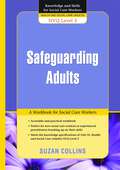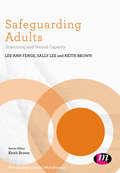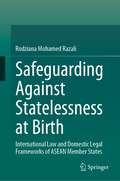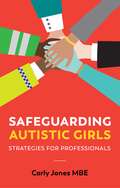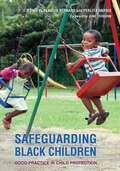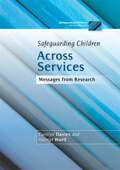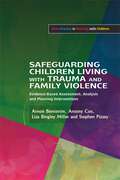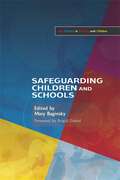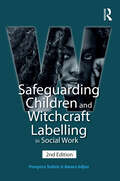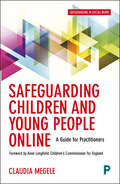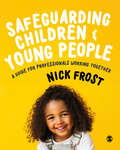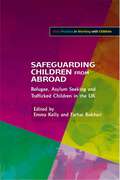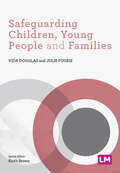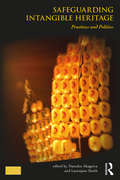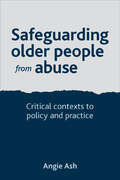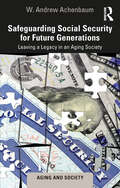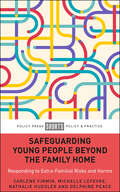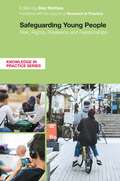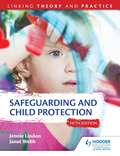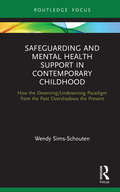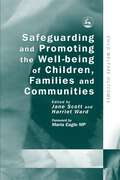- Table View
- List View
Safeguarding Adults: A Workbook for Social Care Workers
by Suzan CollinsWorking in residential or domiciliary settings involves a responsibility to safeguard adults from harm and abuse. This workbook will provide staff and relatives with the ability to make sensible choices concerning prevention and protection, as well as responding to and reporting concerns. Safeguarding Adults examines the different forms of abuse, where abuse can take place and how and where to report the suspected abuse. The workbook meets the requirements of care standards and promotes best practice by enabling staff to feel confident contributing to keeping the people they support safe from harm and abuse. Designed to meet the requirements of Health and Social Care (Adults) NVQ Level 3, Unit 35, this workbook is also a valuable source of guidance for any social care worker wanting or needing to improve their practice in relation to safeguarding adults from harm and abuse.
Safeguarding Adults: Scamming and Mental Capacity (Post-Qualifying Social Work Practice Series)
by Keith Brown Lee-Ann Fenge Sally LeeProvides busy social work and health care practitioners with an accessible guide to adult safeguarding in the context of mental capacity and financial abuse. Drawing on evidence and contemporary examples from practice this book will help readers understand the new landscape of safeguarding adults since the implementation of the Care Act 2014 and the introduction of Adult Safeguarding Boards. There are chapters on the current political landscape of adult social work, specific issues and contexts that make people vulnerable (social isolation, mental capacity, dementia), and important methods of assessment and intervention. A range of pedagogical features are also used to aid learning and understanding including the use of case studies, reflection points, brief exercises and further reading.
Safeguarding Against Statelessness at Birth: International Law and Domestic Legal Frameworks of ASEAN Member States
by Rodziana Mohamed RazaliThis book covers the essential aspects of prevention of childhood statelessness focusing on norms governing the subject through the rights to acquire a nationality and to birth registration, two vital safeguards to prevent statelessness among children. Its unique feature lies in its exposition of the international legal norms focusing on prevention of childhood statelessness and systematic analyses of domestic legal frameworks on nationality and birth registration of the 10 ASEAN Member States. This book is designed for a wide range of readers comprising academics, advocates, students, policy makers, and other stakeholders working on statelessness affecting children, especially in Southeast Asia.
Safeguarding Autistic Girls: Strategies for Professionals
by Carly JonesThis honest, to-the-point guide illuminates the experience of young Autistic girls and explores the situations they can easily fall victim to.Powerful case studies show how easily misunderstandings can arise for Autistic girls and help the reader to identify common patterns of abuse.Providing professionals with access to safeguarding strategies that are straightforward to implement and highly effective, this is essential reading for everyone who wants to better understand the challenges faced by this vulnerable group, and ensure they have access to the same opportunities to secure a good education and build safe and happy relationships as their peers.
Safeguarding Black Children: Good Practice in Child Protection
by Derek Kirton Danielle Turney June Thoburn Joanne Westwood Perlita Harris Carlene Firmin Elizabeth Lewinson Anna Gupta Jenny Pearce Jean Clarke Stefan Brown Prospera Tedam Jonathan Scourfield Claudia Bernard Frank Keating Ravinder BarnProviding an exploration of the key issues, this book offers practical advice on how to improve the safeguarding and welfare of black children and young people in need. With contributions from academics, researchers and practitioners, it promotes an understanding of the particular cultural and social issues that affect black children in relation to child protection. It highlights how race and racism, as well as culture, faith and gender, can influence the ways need and risk are interpreted and responded to. Drawing on insights from research evidence, case examples and practice guidelines, it outlines the range of factors that contribute to the vulnerability of black children and describes how to improve techniques of working with minority ethnic families. The book covers issues such as the effects of parental mental health problems, living with domestic violence, child maltreatment, and demonstrates how these might be understood differently for black children and young people. There are also chapters on topics such as female genital mutilation, witchcraft and forced marriage. Essential reading for all social workers and child protection workers, as well as students and support managers, Safeguarding Black Children provides the tools and understanding needed to better support these children.
Safeguarding Children Living with Trauma and Family Violence: Evidence-Based Assessment, Analysis and Planning Interventions
by Brigid Daniel Arnon Bentovim Liza Bingley Miller Stephen Pizzey Antony CoxOffering a systematic approach to evidence-based assessment and planning for children living with trauma and family violence, this practical book shows how to assess and analyse the needs of the child, make specialist assessments where there are continuing safeguarding concerns (using the Assessment Framework) and plan effective child-centred and outcome-focused interventions. The authors analyse the impact of exposure to a climate of trauma and family violence on a child's bioneurological development and on their capacity to form attachments and to develop and reflect on relationships through childhood and adolescence into adulthood. They bring together the assessment of children in need with the evaluation of significant harm and risk, and potential for rehabilitation, and also explore the application of evidence-based approaches to intervention. This book is an essential tool for all front-line practitioners working with child protection, including social workers, child and adolescent mental health practitioners, police officers, probation workers and domestic violence organizations. It is also suitable for undergraduate, postgraduate and post-qualifying students.
Safeguarding Children and Schools
by David Miller John Guest Yvonne Coppard Brigid Daniel Graham Music Simon Hackett Ken Mcculloch Mary Baginsky Susan Mcginnis Ann Raymond Louise Laskey Abigail Taylor Enid Hendry Felicity Fletcher-Campbell William Baginsky Lyn Tett Emma WestcottSafeguarding Children and Schools explains how schools are able to contribute to keeping children safe from harm and promoting their welfare, in line with Government Every Child Matters guidelines. The contributors, who are all experts in the field of child protection, put the potentially daunting task faced by schools in context, explaining relevant policy, the latest research findings and offering practical examples to help schools to be more proactive and meet their responsibilities successfully. Areas discussed include the roles of local education authority services and schools in child protection, working with particularly vulnerable or difficult children, the relationship between safeguarding and the curriculum, and training school staff to safeguard children. At a time when expectations of the role of schools are evolving, this book provides guidance and support for teachers, managers and social care professionals. Best Practice in Working with Children Series Edited by Brigid Daniel, Professor of Social Work, Department of Applied Social Science, University of Stirling The titles in the Best Practice in Working with Children series are written for the multi-agency professionals working to promote children's welfare and protect them from harm. Each book in the series draws on current research into what works best for children, providing practical, realistic suggestions as to how practitioners in social work, health and education can work together to promote the resilience and safety of the children in their care. Brigid Daniel is Professor of Social Work in the Department of Applied Social Science at the University of Stirling. She is co-author of several textbooks and practice resources on child care and protection. She was a member of the multi-disciplinary team that carried out a national ministerial review of child protection practice in Scotland.
Safeguarding Children and Witchcraft Labelling in Social Work
by Prospera Tedam Awura AdjoaThis unique resource is perfect for all professionals who wish to understand witchcraft branding as a contemporary form of child abuse.Witchcraft accusations against children are occurring ever more frequently in the UK yet continue to be underestimated by social workers and other professionals. This book serves as an invaluable resource, detailing the frequent witchcraft accusations and child abuse within minority communities in the UK.This second edition emphasises the persistence of witchcraft labelling and highlights new ways of theorising which have emerged, such as contextual safeguarding. Reflective questions, practice dilemmas and relevant links to contemporary policy are provided throughout the book with commentary and reference to updated legislation and professional standards in social work.Written in an accessible style, it gives a unique and honest insider’s perspective of this form of cruelty and abuse suffered by children, with contemporary research and serious case reviews featured in each chapter. New content for this edition includes: Islamic perspectives, culturally sensitive contextual safeguarding, trauma-informed approaches, and BLM/decolonising anti-racist practice Overall, this is a must-read for social workers and other professionals working with children.
Safeguarding Children and Young People (The Social Work Skills Series)
by Stella Coleman Corinne May-ChahalWhat does the novice practitioner or the experienced practitioner moving into child care work from another sector need to know to practice effectively? What skills do they need to call on?In this valuable addition to The Social Work Skills Series, Stella Coleman and Corinne May-Chahal bring together their considerable teaching and practice experience to provide a reliable and practical guide to child protection work. Topics covered include: the legal and procedural context the professional context explanatory theoretical frameworks and models of practice managing risk evidence-based practice social work interventions parents, carers and families continuing professional development. This is an essential text for all students, teachers and professionals working with children and families.
Safeguarding Children and Young People Online: A Guide for Practitioners
by Claudia MegeleDrawing on the latest research, theory and practice, this is the first book to provide social workers with an evidence-based, practical guide to safeguarding children and young people from abuse, in a world of sexting, selfies and snap chat. It presents an overview of the key e-safety and online risks to children and young people, including dark play, digital self-harm, and online grooming, sexualisation, bullying, offending and radicalisation. It also examines online boundaries, relationships and identity and the future of technologies. Case study examples and discussion of key principles will help social workers consider, mitigate and manage online risks and their effects for safeguarding children and young people, and their families and carers.
Safeguarding Children and Young People: A Guide for Professionals Working Together
by Nick FrostSafeguarding Children and Young People offers students and practitioners an accessible and multi-disciplinary guide to working together with other professionals to deliver a child-centred and co-ordinated approach to safeguarding, in line with the Working Together to Safeguard Children guidance. Taking a ‘whole systems’ approach, and offering support on prevention, assessment, intervention, systems, and leadership, the book reflects on recent challenges including contextual abuse, child sexual exploitation and cyber-abuse. The book includes case studies, activities and points for reflection to aid learning and test understanding.
Safeguarding Children and Young People: A Guide for Professionals Working Together
by Nick FrostSafeguarding Children and Young People offers students and practitioners an accessible and multi-disciplinary guide to working together with other professionals to deliver a child-centred and co-ordinated approach to safeguarding, in line with the Working Together to Safeguard Children guidance. Taking a ‘whole systems’ approach, and offering support on prevention, assessment, intervention, systems, and leadership, the book reflects on recent challenges including contextual abuse, child sexual exploitation and cyber-abuse. The book includes case studies, activities and points for reflection to aid learning and test understanding.
Safeguarding Children from Abroad: Refugee, Asylum Seeking and Trafficked Children in the UK
by Catherine Shaw Ruth Reed Hannah Pearce Stefan Stoyanov Farhat Bokhari Phil Ishola Nadine Finch Mina Fazel Emma Kelly Heaven Crawley Savita De SousaChildren from abroad who are alone in the UK are vulnerable and at increased risk of harm without the care and protection of their parents or caregivers. They may be unaccompanied asylum seekers, refugees, or victims of trafficking. This book examines the issues and problems faced by these children, what their needs are, and how these needs should be met in order to ensure their effective safeguarding. It demonstrates that these children often receive a different level of service to children who are UK citizens, and examines how these gaps in services can be addressed. Chapters cover the identification and age assessment of separated children, accommodation provision, private fostering, mental health, detention and returns, and the role of the guardian. Case studies and best practice points are included throughout the book. This important book will be essential reading for all those who encounter separated children, including social workers, counsellors, health care professionals and those working in the voluntary sector.
Safeguarding Children, Young People and Families (Post-Qualifying Social Work Practice Series)
by Vida Douglas Julie FourieKeeping children and young people safe is everybody’s responsibility. This requires health, social care and education professionals to make sense of complex family situations that are placing a child or young person at risk of harm. This is no easy feat. The actions we take matter and we need to get this right if we are to truly make things better and improve outcomes for children and young people. Using case studies, reflective questions and checklists for practice, this hands-on guide will provide you with the knowledge and skills you need to effectively and confidently make a difference to the lives of children and young people. This series of books from Learning Matters is aimed at busy social work and health care practitioners, particularly in the context of integrated health and social care, who are looking to enhance their skills and extend their knowledge. Written from a practical point of view, they have clear links to both qualifying training as well as CPD. They are up-to-date, accessible and totally skills focused.
Safeguarding Children, Young People and Families (Post-Qualifying Social Work Practice Series)
by Vida Douglas Julie FourieKeeping children and young people safe is everybody’s responsibility. This requires health, social care and education professionals to make sense of complex family situations that are placing a child or young person at risk of harm. This is no easy feat. The actions we take matter and we need to get this right if we are to truly make things better and improve outcomes for children and young people. Using case studies, reflective questions and checklists for practice, this hands-on guide will provide you with the knowledge and skills you need to effectively and confidently make a difference to the lives of children and young people. This series of books from Learning Matters is aimed at busy social work and health care practitioners, particularly in the context of integrated health and social care, who are looking to enhance their skills and extend their knowledge. Written from a practical point of view, they have clear links to both qualifying training as well as CPD. They are up-to-date, accessible and totally skills focused.
Safeguarding Intangible Heritage: Practices and Politics (Key Issues in Cultural Heritage)
by Laurajane Smith Natsuko AkagawaThe UNESCO Convention for the Safeguarding of the Intangible Cultural Heritage came into force in 2006, framing the international and national practices and policies associated with intangible cultural heritage. This volume critically and reflexively examines these practices and policies, providing an accessible account of the different ways in which intangible cultural heritage has been defined and managed in both national and international contexts. As Safeguarding Intangible Heritage reveals, the concept and practices of safeguarding are complicated and often contested, and there is a need for international debate about the meaning, nature and value of heritage and what it means to ‘safeguard’ it. Safeguarding Intangible Heritage presents a significant cross section of ideas and practices from some of the key academics and practitioners working in the area, whose areas of expertise span anthropology, law, heritage studies, linguistics, archaeology, museum studies, folklore, architecture, Indigenous studies and history. The chapters in this volume give an overarching analysis of international policy and practice and critically frame case studies that analyze practices from a range of countries, including Australia, Canada, China, Indonesia, Japan, Korea, Kyrgyzstan, New Zealand, Taiwan, the UK and Zimbabwe. With a focus on conceptual and theoretical issues, this follow-up to Intangible Heritage, by the same editors, will be of great interest to students, scholars and professionals working in the fields of heritage and museum studies, heritage conservation, heritage tourism, global history, international relations, art and architectural history, and linguists.
Safeguarding Older People from Abuse: Critical Contexts to Policy and Practice
by Angie AshThe mistreatment of older people is increasingly recognised internationally as a significant abuse of elders’ human rights. ‘Scandals’ and inquiries into the failure to protect older people from abuse in health and social care systems rarely address, and still less challenge, the social, economic and cultural context to the abuse of older people. This critical and challenging book makes a strong case for the development of ethically-driven, research-informed policy and practice to safeguard older people from abuse. Drawing on findings of original UK research and framed in an international context, it illustrates ways in which ageism, under-resourced services to older people, target-driven health and social care policy and services, and organisational cultures of blame and scapegoating, are a powerful yet invisible backcloth to elder abuse. Safeguarding older people from abuse will be essential reading for policy makers, politicians, professionals, campaigners, researchers and educators, and those working in criminal justice fields.
Safeguarding Social Security for Future Generations: Leaving a Legacy in an Aging Society (Aging and Society)
by W. Andrew AchenbaumThis book offers a unique multigenerational approach to saving Social Security. Public programs have adapted to societal aging, but fears overwhelm hopes for Social Security’s future prospects. Conservatives want to privatize operations that liberals seek to expand. Younger workers are happy that Social Security protects their elders, but most do not expect benefits when needed. Achenbaum reframes conflicting perspectives and offers new models of respectful transgenerational dialogue that can mobilize pragmatic reforms. Designed for use in gerontology, social work, and public policy courses, Safeguarding Social Security for Future Generations offers measured hope for leaving a legacy that safeguards the common good.
Safeguarding Young People Beyond the Family Home: Responding to Extra-Familial Risks and Harms
by Nathalie Huegler Carlene Firmin Michelle Lefevre Delphine PeaceEPDF and EPUB available Open Access under CC-BY-NC-ND licence. During adolescence, young people are exposed to a range of risks beyond their family homes including sexual and criminal exploitation, peer-on-peer abuse and gang-related violence. However, it has only been over the past two decades that the critical safeguarding implications of these harms have started to be recognised. Social care organisations are increasingly experimenting with new approaches but continue to experience challenges in supporting affected young people and their families. This book analyses the results of the first rapid evidence assessment of social care organisations’ responses to risks and harms outside the home across 10 countries. The authors highlight key areas for service development, give insights into how these risks and harms can be understood, and consider wider implications for policy and practice.
Safeguarding Young People: Risk, Rights, Resilience and Relationships (Knowledge in Practice)
by Christine Cocker John Coleman Nick Marsh Carlene Firmin Jenny Pearce Ann Hagell Adi Cooper Jenny Lloyd Michelle Lefevre Rachel Knowles Helen Beckett Lauren Wroe Kristine Hickle Jahnine Davies Camille Warrington Whitney Clark Marney HallFocusing on young people and adolescence, this book explores the complexity of contemporary adolescent safeguarding. It highlights evidence-informed practice and innovation in this area at the work, serving as an accessible and invaluable resource for all working with and supporting young people facing risk and harm.Core themes covered by the book are the nature of harms facing some young people, the potential pitfalls of some professional responses, and the current legal framework for safeguarding young people where harm occurs outside the family home. It includes an overview of adolescent development, and argues for a holistic, systemic response that addresses the structural disadvantage facing many young people at risk and incorporates participatory and trauma-informed practice designed to promote resilience. It draws on innovative approaches in local areas, such as Transitional Safeguarding, to make the case for a person-centred, evidence-informed and rights-based approach to safeguarding young people. As well as being invaluable to practitioners, managers and strategic leaders working in this field, this is also ideally suited to be a text for any social work course or professional development programme on adolescent safeguarding practice.
Safeguarding and Child Protection 5th Edition: Linking Theory and Practice
by Jennie Lindon Janet WebbEnsure your students link theory with practice with this updated version of the authoritative and accessible series from Jennie LindonLinking Theory and Practice has helped thousands of students make the right connections between their lectures and the real settings that they go on to work in. This latest edition of Safeguarding and Child Protection provides a useful overview of the subject in straightforward language that allows novices to access the more complicated concepts. Jennie Lindon's trademark approach provides a trusted and authoritative voice for a wide range of courses, including undergraduate and foundation degrees in Early Years and Early Childhood, PGCEs and BEd programmes.· Includes detailed references for further reading with descriptions of 'key texts' for each chapter· 'Pause for reflection' feature provides numerous opportunities to think about the impact of their own role.- Provides an essential practical toolkit for anyone who works with children.
Safeguarding and Child Protection 5th Edition: Linking Theory and Practice
by Jennie Lindon Janet WebbEnsure your students link theory with practice with this updated version of the authoritative and accessible series from Jennie LindonLinking Theory and Practice has helped thousands of students make the right connections between their lectures and the real settings that they go on to work in. This latest edition of Safeguarding and Child Protection provides a useful overview of the subject in straightforward language that allows novices to access the more complicated concepts. Jennie Lindon's trademark approach provides a trusted and authoritative voice for a wide range of courses, including undergraduate and foundation degrees in Early Years and Early Childhood, PGCEs and BEd programmes.· Includes detailed references for further reading with descriptions of 'key texts' for each chapter· 'Pause for reflection' feature provides numerous opportunities to think about the impact of their own role.- Provides an essential practical toolkit for anyone who works with children.
Safeguarding and Mental Health Support in Contemporary Childhood: How the Deserving/Undeserving Paradigm from the Past Overshadows the Present
by Wendy Sims-SchoutenApproaches regarding safeguarding and mental health in childhood have been in constant flux. Framed within a critical realist ontology, this book provides insight into causal factors (individual, material, institutional) and social structures that impact on the continued legacy of the ‘deserving/undeserving' paradigm. Drawing on historical data from children taken into care by the Waifs and Strays Society (1881–1918) and contemporary data from interviews with young care leavers and safeguarding practitioners/professionals, this book shows how at present and in the past, certain children and families miss(ed) out on support and interventions due to complex needs, financial cuts and ever-changing thresholds. It is the group of children referred to as ‘victims’, a term used for the most disadvantaged children who have spent time in care, have complex mental health needs and have had the most damaging pre-care family experiences, who are the focus of this book. This book shows that in an attempt to provide services where there are ever increasing thresholds for access and cuts to resources, a resurgence of the ‘deserving/undeserving’ paradigm reflects a contemporary justification regarding who is 'entitled' to help and who is not. This book will be of interest to all scholars and students of social work, social policy, childhood studies, sociology and education policy.
Safeguarding and Promoting the Well-being of Children, Families and Communities
by Jane Scott Harriet WardImproving the well-being of children is more effective when social care professionals work with the children's parents, families and communities. This collection brings together innovative interventions designed to nurture children's health and welfare, and analyses which types of programmes are most effective and why. The contributors explore the impact of poverty on children's development and assess national initiatives set up to assess and reduce need. They present examples from the UK, US, Canada and Australia of specific interventions to counter or prevent difficulties in the domains of child development, parenting capacity and wider environmental factors. Many contributions demonstrate the importance of engaging with service users and helping communities to shape and direct their own programmes for change. The final section of the book presents useful approaches to assessing and evaluating services. Demonstrating the need for close inter-agency collaboration and `joined up' services, this book is essential reading for policy makers, managers and practitioners in child welfare agencies, and social work academics and students.
